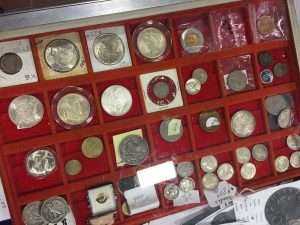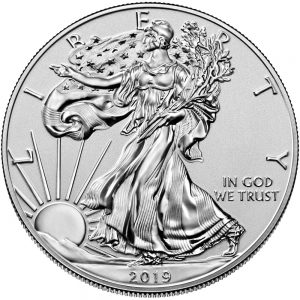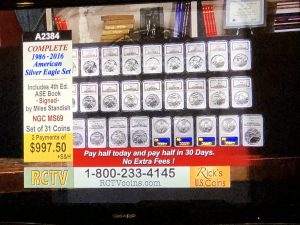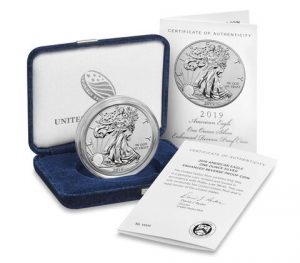Weekly World Numismatic News for January 30, 2022
 Several news stories touted the collecting of coins and said that coins are a great teaching tool.
Several news stories touted the collecting of coins and said that coins are a great teaching tool.
A Chicago Sun-Times article suggested that parents use national coin storage to teach their kids history and economics. Coins have images of presidents, and presidents represent history. For example, the 50 State Quarters and America the Beautiful Quarters can help teach geography and history. Even though the Ohio quarter has a hanging astronaut, a parent can use it to explain aviation history.
From Ghent, New York, Ralph Gardner Jr. asks if coin collecting is making a comeback? Gardner admits that regular coin collecting is not a good investment. The opportunity for change hunting is limited, and the regular collector market is dominated by graded coins that are out of the reach of ordinary collectors. But there continue to be opportunities for someone who likes coins to find something interesting to collect.
Finally, a New York Times print edition published an editorial cartoon that compared coin collecting to cryptocurrency. The gist of the cartoon was to show that while there may be investment opportunities in the cryptocurrency market, if something happens in either market, the coins are a tangible asset.
Recently, I received emails from people looking for information about buying collectible coins. Most have said they were participating in the crypto markets but were worried about its volatility. The number of messages increased this past week during a decline in the crypto market. The crypto investors with the capital are looking for a safe haven and choosing collector coins for their investment.
As a result, the collector and investor market appears to be strong. The only problem is understanding what everyone wants to collect.
And now the news…
 → Read more at chicago.suntimes.com
→ Read more at chicago.suntimes.com
 → Read more at marketplace.org
→ Read more at marketplace.org
 → Read more at the-sun.com
→ Read more at the-sun.com
 → Read more at berkshireeagle.com
→ Read more at berkshireeagle.com
An Interesting Pocket Change Find
 After a busy and short week, I finally had a moment to empty my pockets and examine the week’s change. Even after all of these years, I continue to search through my pocket change to try to find something interesting. These days I most look at the quarters trying to find an elusive W mintmark.
After a busy and short week, I finally had a moment to empty my pockets and examine the week’s change. Even after all of these years, I continue to search through my pocket change to try to find something interesting. These days I most look at the quarters trying to find an elusive W mintmark.
As I looked at the pile, I was drawn to something very different. It was larger than a quarter. When I picked it up, I noticed that it was a 1971 Mexican one peso coin.
Thinking back from when I last emptied my pockets on Saturday to yesterday, I cannot remember when I could have received the coin. At the grocery store, I tend to use the self-service checkout lane, especially at night, when I am too tired to attempt a coherent conversation. Coin-op devices will not accept or dispense foreign coins.
I tried playing MegaMillions and Powerball. Most stores now have automated machines that only accept credit cards and paper money.
During my periodic coffee stops, I use the app to make those purchases with no chance to gather more coins.
If I received the peso instead of a quarter, I lost 20-cents in the transaction. At current market rates, the peso is only worth 5-cents. The coin might have a numismatic value of about 20-40 cents.
Regardless of the net results, it is a fun pocket change find.
Collectors are upset with the Mint but there may be a solution
 The result of the sale of the Enhanced Reverse Proof 2019-S American Eagle continues to reverberate through the hobby. Industry reporters continue to hear from collectors that they feel like the U.S. Mint is taking them for granted.
The result of the sale of the Enhanced Reverse Proof 2019-S American Eagle continues to reverberate through the hobby. Industry reporters continue to hear from collectors that they feel like the U.S. Mint is taking them for granted.
The biggest question is, how did all of these dealers get these coins in inventory? How did others find the stock to flip on sites like eBay?
Dealers and speculators are at it again. It is similar to the chaos they caused for the opening of the 2014 JFK 50th Anniversary Gold Proof Coin. They hired people to shand in line for them who caused a near riot. Now, they have taken these manners to cyberspace.
How can the U.S. Mint fix the issue?
The best answer I have heard came from William T. Gibbs at Coin World, who suggested a dedicated sales window for established customers. Gibbs wrote:
What an excellent idea!
The U.S. Mint can create a “Collector’s Club” where non-commercial customers can earn points. The more points, the closer to the front of the line you get to access limited edition items. They can slowly add perqs for better customers, including levels for reduced and free shipping.
There is no reason to prevent the U.S. Mint from making the Collector’s Club a policy. The only question is whether they have the wherewithal to implement something like this. I do not think they do, but I hope they prove me wrong!
Weekly World Numismatic News for November 24, 2019

Maine Troop Greeters Coin – Created to commemorate the 3,000th flight greeted, March 22, 2008 (Image courtesy of the Maine Troop Greeters)
As part of their work greeting service members coming home from the world outpost, the service members leave their challenge coins with the greeters as a token of appreciation. Within the last few years, the organization created a museum within the Bangor International Airport for these challenge coins. With over 6,000 in their collection, they have documented their holdings, making it available for all collectors.
The database provides color images of each of the challenge coins with a description of size, shape, and devices. If you have a challenge coin you cannot identify, you can search the database for keywords found on the coin. It is a simple yet effective idea.
According to their website, the Main Troop Greeters are slowing their growth and winding down operations as the number of troops overseas decreases. They have done a great service welcoming back soldiers returning from overseas wars. Hopefully, their work will not have to be duplicated in the future.
And now the news…
 → Read more at wabi.tv
→ Read more at wabi.tv
 → Read more at foxnews.com
→ Read more at foxnews.com
 → Read more at thevintagenews.com
→ Read more at thevintagenews.com
 → Read more at pravdareport.com
→ Read more at pravdareport.com
 → Read more at indiatimes.com
→ Read more at indiatimes.com
 → Read more at blabbermouth.net
→ Read more at blabbermouth.net
 → Read more at foxnews.com
→ Read more at foxnews.com
 → Read more at bbc.com
→ Read more at bbc.com
DON’T BUY COINS ON TELEVISION!
Over the years, I have heard from many people regarding the problems with mailorder numismatics. Every few months, someone writes and asks about the value of something they bought from a non-numismatic magazine or from something they saw on television.
My answers tend to be upsetting because the market does not value these items as the television hucksters do.
Recently, I wrote about the experience with someone who brought in a box of coins he bought from television and magazines. I described his reaction as “The look on his face when I told him was as if I kicked his dog.” Then I was provided an example of why my words land very hard.
Sunday’s are my day off. Even though I have personal work to catch up on, I will play couch potato and watch television. This past Sunday, I entered the wrong number in the remote and landed on the Fox Business channel.
 On the weekend, when the markets are not open, the business channels broadcast other programming. At this time, Fox Business was airing an infomercial for Coins TV.
On the weekend, when the markets are not open, the business channels broadcast other programming. At this time, Fox Business was airing an infomercial for Coins TV.
When I tuned in, the camera was panning a display with graded American Silver Eagle coins. Of course, I stopped to stare at the shiny silver coins. Then I heard the pitch.
The pitchman is Rick Tomaska, owner of Rare Collectibles TV. Tomaska seemed pleasant and appeared knowledgable. His pitch was selling a date run of American Silver Eagle graded MS-69 by NGC for $1,995.00. It almost seemed reasonable until it was made clear that the pitch was for a date run of 31 coins from 1986-2016.
Is $1,995.00 a good deal for the 31 coins? My first instinct was to check the price guides. Since the online Greysheet does not include the retail price for graded bullion coins (why?), I used two other guides: Numismedia Fair Market Value Price Guide and the price guide from NGC. Based on a grade of MS-69, the guides provided the following information based on prices for the 1986-2016 34-coin set:
| Numismedia FMV 34 coins @ MS-69 |
NGC Price Guide 34 coins @ MS-69 |
RCTV Infomercial 31 coins @ MS-69 |
|
|---|---|---|---|
| Total | $1,240.00 | $1,679.00 | $1,995.00 | Average | $40.00 | $54.16 | $64.35 |
But Numismedia and NGC are price guides. Guides are not the retail prices a collector would pay. So we turn to the interwebs to search for “date run American Silver Eagle coins.” The search returned several entries on the first page that was not RCTV.
Taking the top three entries from the search, only one dealer was sold out. The others offered a complete set of 34 coins, 1986-2019, graded MS-69 by NGC for considerably less than Tomaska’s price. To be fair, where there was a difference between the cash and credit prices, I used the credit card price, which is usually higher. Then I searched eBay and sorted for the lowest price. The following is what I found:
| Company | Date Run | Coins in Set | Advertised Price | Shipping | Average per coin |
|---|---|---|---|---|---|
| RCTVcoins.com | 1986‑2016 | 31 | $1995.00 | $64.35 | |
| JM Bullion | 1986‑2019 | 34 | $1541.70 | $45.34 | |
| Mint Products.com | 1986‑2019 | 34 | $1399.99 | $41.18 | |
| eBay Seller constitutionclct | 1986‑2019 | 34 | $1299.00 | $14.95 | $38.65 |
For the eBay dealer who was charging for shipping, the cost per coin was the lowest even after adding the shipping costs to the total price.
 JM Bullion and Mint Products.com are reputable companies. Both firms are worth considering if you do not feel comfortable making this purchase from an eBay seller. Note that these companies will base the price of their bullion coins on the current spot price of silver. Their retail prices may fluctuate.
JM Bullion and Mint Products.com are reputable companies. Both firms are worth considering if you do not feel comfortable making this purchase from an eBay seller. Note that these companies will base the price of their bullion coins on the current spot price of silver. Their retail prices may fluctuate.
When you buy from these television advertisements, you will overpay.
To help enforce the issue, the JM Bullion website said that they would buy a complete date set of American Silver Eagle bullion coins for $1,094.12 when I looked up the price. If you purchased the set advertised on television, you would be LOSING $900!
As part of the pitch, if you ordered the set, Tomaska would send a copy of the 4th Edition of American Silver Eagle: A Guide to the U.S. Bullion Coin Program autographed by Miles Standish, the book’s co-author, who was present with Tomaska.
What is sad is that Miles Standish joined Tomaska as part of this infomercial. Although Standish did not assist Tomaska in his pitch for the set, his presence is an appearance of legitimacy. It is similar to the appearance of past ANA President David Ganz on an infomercial. Neither endorsed the product that was being sold, but their presence was used to suggest otherwise.
I would not recommend buying coins or any collectible from a television show. Every collectible I have seen being hawked on television was 45-60 percent over what might be considered wholesale value for its market.
As a small business owner, I would be foolish to criticize someone for making a profit. It’s the Ameican way. However, there is a difference between making a profit and price gouging. It is why I am warning you against purchasing collectibles from a pitch on television.
Weekly World Numismatic News for November 17, 2019
 The biggest numismatic-related news of the week that not reported in many media outlets. It was the failure of the U.S. Mint to deal with a high volume of orders for what everyone anticipated would be a popular product.
The biggest numismatic-related news of the week that not reported in many media outlets. It was the failure of the U.S. Mint to deal with a high volume of orders for what everyone anticipated would be a popular product.
On November 14, 2019, the numismatic community rushed to the U.S. Mint website. It flooded their call center attempting to purchase the 2019 American Eagle One Ounce Silver Enhanced Reverse Proof Coin. As with almost all of their past launches, the U.S. Mint e-commerce systems failed the collecting community.
Collectors reported web failures, outages, and disconnection on the telephone trying to order the product. I was first alerted of a problem by a family member and my mailbox filled with readers who experienced similar issues.
After hearing the criticism, the U.S. Mint issued the following statement:
To try to spin this further, on Friday, the U.S. Mint issued the following statement:
With all due respect to the U.S. Mint, if this is beyond your capacity, then the competence of the Mint and their contractor (aren’t they contracted with Pitney-Bowes?) are in question. There are e-commerce systems that have higher capacity requirements and service their customers better.
The failure of their e-commerce system is not a new problem for the U.S. Mint. We can go back through the history of this blog to note how badly they have implemented their e-commerce systems.
Frankly, I am not surprised. Years ago, when I was a contractor within the Department of the Treasury, I had to listen to how the U.S. Mint’s systems were built to be greater and better than anyone else in the department. Their technology directors touted their capacity and their capabilities over all the other bureaus. They used these reasons to allow them to separate themselves and to avoid integration with other systems, even suggesting that they be the central integrators for the department.
Even though I have not worked within the Treasury Department in many years, the results and the spin published by their public relations department demonstrates that the chutzpah continues.
For four years, the U.S. Mint has been holding forums to try to learn from collectors what they expect. One thing they have not learned is to fix the mechanisms that provide collector access to U.S. Mint products. It is time for the U.S. Mint to stop talking and do something. Their problems have surpassed annoying and are bordering on malfeasance!
And now the news…
 → Read more at qcostarica.com
→ Read more at qcostarica.com
 → Read more at wzzm13.com
→ Read more at wzzm13.com

